80 years ago, Otto Hahn and Lise Meitner made a discovery that led to nuclear weapons – yet Meitner was never given the recognition she deserved
With every passing year our communal memory of world war two depends more on archived words and pictures, and less on shared recollections of lived experience. But although many events of that era are now significant only to historians, there are two – the Holocaust and the first nuclear explosion – which still overshadow us all today. In the list of distinguished scientists whose lives were touched by those two cataclysms, the names of Otto Hahn and Lise Meitner stand out prominently.
The combination of Hahn’s expertise in chemistry with Meitner’s in physics opened the door to artificially induced nuclear fission. And when Meitner fled from Nazi persecution in 1938, Hahn gave her his mother’s diamond ring to bribe a border guard with. They both died in 1968, honoured as major contributors to science – though some argue that Meitner did not receive all the recognition she deserved. With the benefit of half a century’s hindsight we may now be better placed to consider their achievements objectively.
Pioneering studies
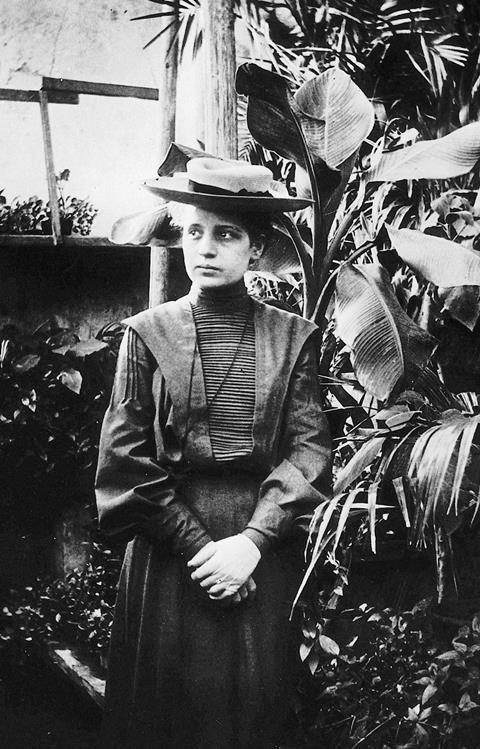
Elise (later shortened to Lise) was born in Vienna, Austria. in 1878, the third of eight children of Philipp and Hedwig Meitner. Both parents were of Jewish heritage but not religiously observant, and their children were eventually baptised as Christians. Philipp was a lawyer and a renowned chess master, while Hedwig was a talented musician, and their home became a hub of cultural activity. Lise played the piano competently, and her sister Auguste had considerable success as a performer, conductor and composer.
Lise found science fascinating, but was advised to focus on subjects that would be more useful if she became a school-teacher. However, when the University of Vienna opened its doors fully to women in 1897 she undertook an intensive course of study to qualify for admission, and 1905 became the second woman to earn a science PhD there. Her thesis was on thermal conduction in various media, but she was already interested in radioactivity.
The following year Meitner went to Berlin in Germany to study the latest developments in physics. She attended Max Planck’s lectures on quantum theory, but as a woman was denied access to the university’s laboratories. Fortunately, the ban did not apply to Otto Hahn’s improvised radiochemistry lab, which was in a converted cellar with a separate entrance. After meeting Meitner at a physics colloquium, Hahn welcomed her as an unofficial (and unpaid) assistant.
Radiochemistry apprenticeship
Though younger than Meitner, Hahn was further up the academic ladder. Born in 1879, he was the son of a Frankfurt businessman who had wanted him to become an architect. But at the University of Marburg, he was captivated by chemistry, and after graduation (and a year’s compulsory military service) he sought a career in Germany’s expanding chemical industry. In September 1904, having been advised by a potential employer to improve his language skills, he became an assistant to William Ramsay at University College London in the UK, a leading centre of radiochemical research.
Hahn worked with Ramsay, Rutherford and Fischer before collaborating with Meitner
As Hahn’s thesis had been on organic chemistry, Ramsay instructed him to prepare organic compounds of radium. While doing so, Hahn discovered what appeared to be a new element (later found to be an isotope of thorium). With Ramsay’s recommendation, Hahn spent another year doing radiochemistry under Ernest Rutherford at McGill University in Montreal, Canada. He returned to Germany in 1906 as an assistant to the organic chemist Emil Fischer at Berlin University, gaining his licence to teach there in 1907. In November that year he encountered Meitner, and their collaboration began.
Hahn became a professor at Berlin in 1910, and in 1912 was appointed the head of radiochemistry at the newly-established Kaiser Wilhelm Gesellschaft (KWG) – an independent research institute in the Berlin suburb of Dahlem, funded by German industrialists. Meitner joined him there as a salaried research assistant. In 1913 Hahn married Edith Junghaus, and Meitner (who never married) was godmother to their only child.
Interrupted by conflict
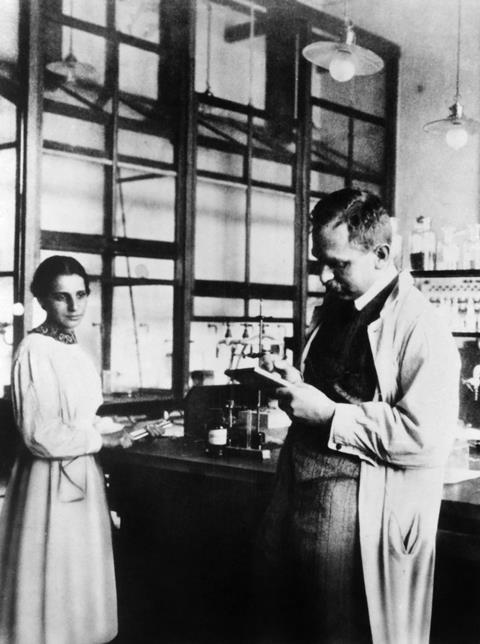
Like others working in their field, Hahn and Meitner struggled to bring order to the multitude of recently-discovered radioactive substances. The picture grew clearer after 1913, when the English chemist Frederick Soddy proposed that some supposedly new elements were variant forms of already known ones, having the same nuclear charge but different nuclear masses; he called them isotopes. In the 1920s, analysis with the mass spectrograph would vindicate this concept, though the identity of some of these short-lived entities remained unclear.
In this confusing environment Hahn’s skill in isolating and chemically characterising candidates for recognition as elements was complemented by Meitner’s flair for detecting and interpreting their radiation signatures. They published significant research papers together until war imposed other priorities on them. Hahn was conscripted in 1914, and after a spell in the infantry worked (reluctantly) on poison gasses. Meitner volunteered as a radiographer with the Austrian army, and endured considerable hardship before returning to civilian life in 1917.
Later that year, during a period of leave, Hahn re-joined her at the KWG, where they isolated the most stable isotope of another new element – protactinium. When peace returned in 1918 their association resumed on a new basis. No longer merely Hahn’s assistant, Meitner was now head of the KWG’s physics division.
In 1926 Meitner became Berlin University’s first female professor – probably the first anywhere in Germany. She was amused when her inaugural lecture on radioactivity and cosmic physics was mistakenly reported as being about ‘cosmetic physics’. Yet this error (or was it a joke?) gives some indication of the obstacles she faced.
Startling news
During the 1920s, subatomic physics was revolutionised by the startling theoretical innovations of Schrödinger, Heisenberg and others. Meanwhile, investigation of the properties of radioactive elements proceeded less dramatically, with Hahn and Meitner playing significant if unspectacular roles. But in the following decade – assisted by Fritz Strassman and Meitner’s nephew Otto Frisch – they made a fundamental breakthrough, just as the world was drifting towards war again.
The history of those troubled times has often been retold, but it still has lessons for us today. After years of economic misery, many German voters were convinced that foreign adversaries and domestic traitors were responsible for their woes. They responded by installing an aggressively nationalistic government, pledged to create a hostile environment for all those it regarded as enemies of the state.
Assisted by fellow-scientists in the Netherlands, Meitner crossed the border safely
Socialists and trade unionists were early targets, but the most extreme measures were directed against Jews – who were stigmatised as ‘rootless cosmopolitans’, or ‘citizens of nowhere’. New laws barred them from the professions, the civil service, and the universities, generating an exodus of experts which included several past and future Nobel laureates.
Hahn was aware that by moving to a university post outside Germany he might deprive a Jewish colleague of a lifeline. Instead, he opted for passive resistance, refusing to join the Nazi party (despite pressure from the university’s management), and eventually resigning his professorship in protest against the dismissal of Jewish colleagues. Meitner, being an Austrian citizen, remained partially exempt from these repressive laws – until Austria was incorporated into the German state in 1938.
Her passport then became invalid, and like others seeking permission to leave the country she was forbidden to take more than ten marks out with her (about the same purchasing power as £50 today). However, assisted by fellow-scientists in the Netherlands she crossed the border safely. The diamond ring Hahn gave her to bribe a frontier guard was not needed, and she later passed it on to her nephew’s fiancée. Meitner found sanctuary in Sweden, and continued corresponding with Hahn. Soon he had startling news for her.
A piece of cake
The key to Hahn’s breakthrough was the neutron, first identified by English physicist James Chadwick in 1932. It had been detected - but not recognised - by Frédéric and Irène Joliot-Curie in Paris the previous year. Lacking an electrical charge themselves, neutrons were not deflected by positively charged atomic nuclei, making them ideal missiles for probing the heart of the atom. Physicists and radiochemists in several countries soon began directing them at a variety of elements.
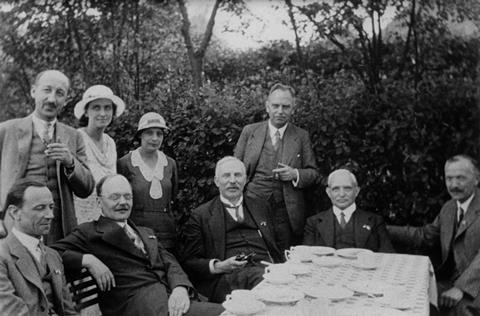
In Italy, Enrico Fermi announced that by bombarding uranium with neutrons he had created heavier elements, previously unknown to science. Although his claims were disputed by the German physicist Ida Noddack, they gained wide support, since they were compatible with the generally accepted model of the atomic nucleus.
As a rough analogy, imagine shooting raisins at a large cake. Some might hit the target squarely and be absorbed, producing a slightly heavier cake. Others might have a glancing impact, detaching small fragments to leave the cake a little lighter. No-one would expect a single shot to cleave it into two different cakes, each about half the size of the original. Yet something similar appeared to happen when Hahn and Strassman fired neutrons at uranium.
What idiots we have all been!
Meitner regarded Hahn as the ablest radiochemist of his time. And in December 1938 his meticulous analyses clearly showed that neutron-bombarded uranium samples contained an element (barium) with approximately half uranium’s atomic mass, which had not been present before. Hahn could see no plausible explanation until Meitner and her nephew Otto Frisch provided one.
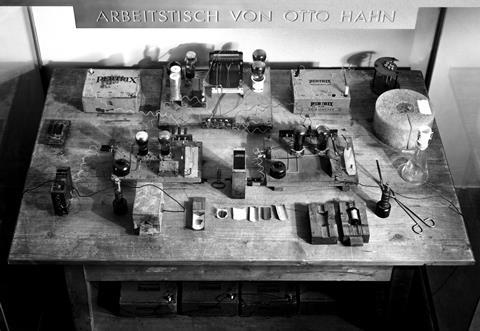
Frisch – then working with Niels Bohr’s research group in Copenhagen – had travelled to Sweden to spend the 1938–39 New Year holiday with his aunt. He found her contemplating Hahn’s puzzling results, news of which had just reached her. While walking through a snowy forest they discussed how a uranium atom might be split to create a barium atom, and then sat down on a convenient log to do some calculations.
Both knew of Bohr’s speculative ‘liquid-drop’ model of the atomic nucleus, which implied that very large nuclei like uranium’s would be unstable. If that were so, the impact of a neutron might indeed cause one to break up. After estimating the masses of the fragments likely to result from such a collision, Meitner found that about one-fifth of a neutron’s mass remained unaccounted for. This, she concluded, was converted into energy in accordance with Einstein’s E = mc2 equation.
When Frisch returned to Copenhagen with the news, Bohr immediately exclaimed ‘Oh, what idiots we have all been! Oh, but this is wonderful!’ Bohr publicised the discovery at a physics conference in the US later in January 1939, and soon others were confirming Hahn and Strassman’s results and Meitner and Frisch’s calculations. It was quickly recognised that fission of uranium’s 235 isotope would release further neutrons, possibly starting a chain reaction. On the eve of another war, the nuclear age had begun.
Honours even?
Throughout the conflict Meitner remained in Sweden, refusing to join the Allied atomic bomb project, which she felt was abhorrent. Frisch had taken a temporary job at the University of Birmingham in the UK in the summer of 1939, and did not return to Denmark in the autumn. Instead he worked on Britain’s nuclear research programme, before joining the US Manhattan Project at Los Alamos in 1943.

Hahn continued doing radiochemical research until his laboratory was wrecked by Allied bombing. He never participated in Germany’s nuclear bomb project, but when the European war ended in May 1945 he was interned in England along with other leading German scientists. On learning of the devastation of Hiroshima and Nagasaki he was grieved that his work had made this possible, and briefly contemplated suicide.
While still in custody, Hahn heard that he had just won the 1944 Nobel prize for chemistry, the award having been deferred for a year. After returning to Berlin in 1946 he was appointed head of the newly-established Max Planck Gesellschaft – a replacement for the KWG, which the occupying powers had disbanded because of its links with the Nazi regime. Thereafter Hahn campaigned against the spread of nuclear weapons, and was several times nominated for the Nobel peace prize.
Meitner remained in Sweden until her retirement, and then settled in England. She never received a Nobel prize – a decision she accepted gracefully, though others have condemned it as grossly unfair. However, unlike Hahn she now has an element (meitnerium, number 109) named in her honour. It may prove a more enduring memorial.
Mike Sutton is a science historian based in Newcastle, UK
Further reading
O Frisch, What Little I Remember, Cambridge University Press, 1979
Otto Hahn and the Rise of Nuclear Physics, ed W R Shea, Reidel, 1983
R L Sime, Lise Meitner: A Life in Physics, University of California Press, 1996

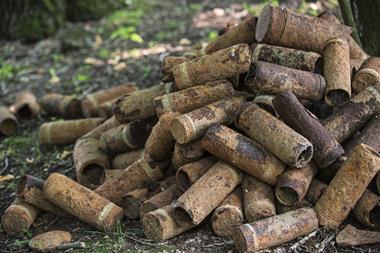

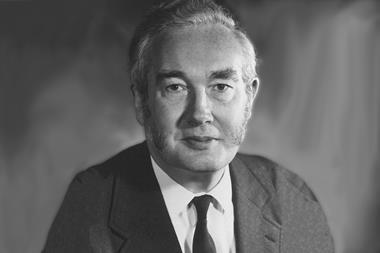









2 readers' comments